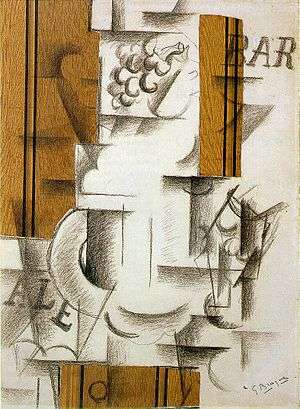Papier collé
Papier collé (French: pasted paper or paper cut outs) is a type of collage and collaging technique in which paper is adhered to a flat mount.[1] The difference between collage and papier collé is that the latter refers exclusively to the use of paper, while the former may incorporate other two-dimension (non-paper) components.[2] As the term papier collé is not commonly used, this type of work is often simply called collage.

Cubist painter Georges Braque, inspired by Pablo Picasso's collage method, invented the technique[3] and first used it in his 1912 work, Fruit Dish and Glass. Braque continued to use the technique in works such as Bottle, Newspaper, Pipe, and Glass.
Papier collé is sometimes also used to refer specifically to the paper collages of the Cubists. [2]
Notable collage artists
Some of the notable collage artists are:
- Georges Braque[3]
- Joseph Cornell[4]
- Kurt Schwitters[1]
- Henri Matisse[1]
- Robert Motherwell[1]
- Robert Rauschenberg[4]
- Kara Walker
- Sergei Parajanov.
References
- Montebello, Philippe de. "Collage: An Introductory Note". In Carmean, E.A., Jr. (ed.). The Collages of Robert Motherwell. The Museum of Fine Arts. LCCN 72-87521.
- Hoffman, Katherine (1989). "Collage in the Twentieth Century: An Overview". Collage: Critical Views. UMI Research Press-University Microfilms Inc. p. 5. ISBN 0-8357-1933-2.
- Cooper, Philip. Cubism. London: Phaidon, 1995, p. 14. ISBN 0714832502
- "Collage | art". Encyclopedia Britannica. Retrieved 2020-04-15.